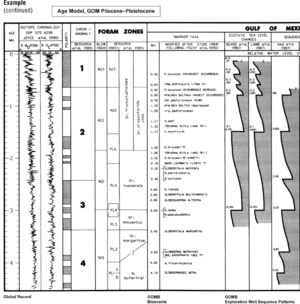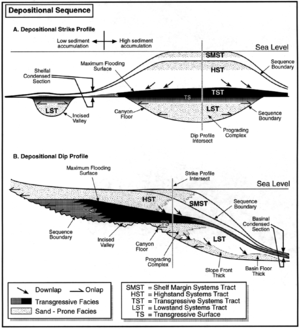Identifying sea level cycle phase with biostratigraphy
| Exploring for Oil and Gas Traps | |

| |
| Series | Treatise in Petroleum Geology |
|---|---|
| Part | Critical elements of the petroleum system |
| Chapter | Sedimentary basin analysis |
| Author | John M. Armentrout |
| Link | Web page |
| Store | AAPG Store |
In basin depocenters, much of the stratigraphic record consists of deposits accumulated during relative lowstand of sea level. These lowstand deposits are separated by condensed intervals containing the distal aspects of the transgressive and highstand systems tracts. Because most of the section is claystone and silty claystone, fossil abundance patterns provide regionally applicable criteria for recognizing systems tracts within a depositional sequence. Upward-increasing fossil abundance suggests rising relative sea level with consequent fossil concentration due to decreasing sediment input. Upward-decreasing fossil abundance suggests falling relative sea level with consequent fossil dilution due to increasing sediment input. Because these strata are largely basinal depocenter deposits of lowstand and condensed section sedimentation, the falling and rising phase of relative sea level changes are correlated to the early phase of lowstand fall and the late phase of low-stand to transgressive rise, respectively.
Example

Within the GOM basin study area, sediment-starved highstand and transgressive deposits merge into the condensed interval. Thick transgressive and highstand deposits occur to the north and in the upper strata of the study area due to the regionally progradational section.[2] Figure 1 is a spontaneous potential (SP) well log illustrating the subdivision of the Glob alt depositional cycle into the mapping intervals for slope and basin facies. The upper and lower data correlate with locally significant condensed sections at 2.8 and 3.1 Ma (Figure 1). The strata between these two condensed sections are divided into presandstone, sandstone, and postsandstone intervals, based on the dominant rock type and the pattern of fossil abundance and biofacies.
Interpretation of example
Because of the basinal location of the Glob alt depositional thick, the biofacies are typically bathyal. In this setting, the subsandstone interval has upward-decreasing fossil abundance away from the fossil abundance peak in the underlying condensed section. This pattern suggests increased rates of sediment accumulation vs. biotic productivity, interpreted as signals of falling sea level. Conversely, the supersandstone interval typically has upward-increasing fossil abundance toward the overlying condensed section. This pattern suggests decreased rates of sediment accumulation vs. biotic productivity and is interpreted as a signal of rising sea level and consequent sediment starvation at the sample site. The sandstone interval typically has few fossils, and those few may reflect very shallow water depths due to downslope transport of the sand by gravity-flow processes. Data from shelf environments have a different set of interpretation criteria [3][1]
Example of mapping systems tracts
Patterns of biofacies distribution reinforce other lines of evidence for variations in relative sea level, such as those illustrated by the distribution of clinoforms (Figure 4-27). When overlain on maps of lithofacies and seismic facies, biofacies patterns that complement other environmental interpretations increase confidence in reconstructions of the geologic history of the study area, including depositional cycle definition and subdivision and facies distribution of potential reservoir and seal rocks (see Armentrout et al[4]).
Biofacies assemblage
Fossil biofacies, calibrated by similarity to modern assemblages, provide information on the type of environment in which specific strata were deposited. Biofacies maps are one type of paleogeographic reconstruction.
Example biofacies maps
The following figure shows biofacies maps of the study area in the Gulf of Mexico. They are based on the subdivision of the Glob alt depositional cycle into presandstone, sandstone, and postsandstone intervals. The importance of these maps is their relationship to lithofacies distribution for potential reservoir rock, seal rock, and source rock. Part A is a presandstone interval map, showing a basinward excursion of outer neritic and upper bathyal biofacies forced basinward by falling sea level Part B is a sandstone interval map in which the biofacies excursion is less pronounced, reflecting maximum lowstand at the turnaround from falling to rising sea level. Part C is the postsandstone interval in which the biofacies excursion is absent due to relative rise of sea level.
Interpreting the maps
Biofacies map patterns are defined by distribution of benthic foraminiferal biofacies.[2][1] Figure 2 shows the biofacies distribution below, within, and above the Glob alt sandstone interval. In upward stratigraphic order, these intervals are interpreted as the sediment accumulated during (1) falling, (2) low, and (3) rising phases of sea level, respectively. A scenario to explain biofacies and sediment patterns in the example is as follows.
- During the lowering of sea level, the biofacies distributions and sites of maximum sediment accumulation move seaward (Figure 2A) where they are deposited on top of the preceding condensed section and associated maximum flooding surface (Figure 3). Within the initial lowering phase, the rate of slope and intraslope basin sediment accumulation increases, with fine-grained deposits above the underlying condensed section. As lowering progresses, the river systems bypass sediment across the shelf, depositing it directly on the upper slope. Remobilized sand and sand supplied directly from rivers during floods may be transported downslope by gravity-flow processes, depositing potential reservoirs.[5] These sands accumulate at changes in the depositional gradient as slope fan and basin-floor fan deposits within the intraslope basins (minibasins).[6]
- The biofacies associated with this lowstand depositional phase, the sandstone interval (Figure 2B), show similar basinward excursion in outer neritic and upper bathyal biofacies as deposited during the presandstone phase. The inner and middle neritic shallow-water biofacies of the sandstone interval show a seaward shift, relative to the seismic stratigraphically defined shelf/slope break—interpreted as an indication of coastal progradation associated with lowered sea level.
- Once sea level begins to rise, the supply of sand-rich sediment to the basinal slope area is rapidly cut off. Mud accumulates during this postsandstone interval, culminating with the overlying upper condensed section. These mudstones and those of the pre-sandstone interval provide a seal for the interbedded lowstand sandstones. The biofacies pattern for this postsandstone interval shows a northward shift toward the basin margin as the coastline regresses across the shelf during transgression (Figure 2C). The occurrences of neritic biofacies of the postsandstone interval do not shift northward as far as their position during the presandstone interval. This is interpreted as sediment accumulation rate exceeding the rate of accommodation space formation by sea level rise plus basin subsidence. The consequence is coastal progradation, as suggested by comparing the mapped patterns of presandstone and postsandstone biofacies in the High Island–East Addition area just west of the seaward extension of the Texas/Louisiana border.
See also
- Sea level cycle phase
- Determining sea level cycle order
- Sea level cycle phase and systems tracts
- Systems tracts identification
- Systems tracts and trap types
- Biofacies and changing sea level
- Constructing age model charts
- Superimposed sea level cycles
- Sequence stratigraphy
- Biostratigraphy in sequence stratigraphy
References
- ↑ 1.0 1.1 1.2 Armentrout, J. M., 1996, High-resolution sequence biostratigraphy: examples from the Gulf of Mexico Plio–Pleistocene, in J. Howell, and J. Aiken, eds., High Resolution Sequence stratigraphy: Innovations and Applications: The Geological Society of London Special Publication 104, p. 65–86.
- ↑ 2.0 2.1 Armentrout, J. M., 1991, Paleontological constraints on depositional modeling: examples of integration of biostratigraphy and seismic stratigraphy, Pliocene–Pleistocene, Gulf of Mexico, in P. Weimer, and M. H. Link, eds., Seismic Facies and Sedimentary Processes of Submarine Fans and Turbidite Systems: New York, Springer-Verlag, p. 137–170.
- ↑ Armentrout, J. M., and J. F. Clement, 1990, Biostratigraphic calibration of depositional cycles: a case study in High Island–Galveston–East Breaks areas, offshore Texas: Proceedings, Gulf Coast Section SEPM 11th Annual Research Conference, p. 21–51.
- ↑ Armentrout, J. M., L. B. Fearn, K. Rodgers, S. Root, W. D. Lyle, D. C. Herrick, R. B. Bloch, J. W. Snedden, and B. Nwankwo, 1999, High-resolution sequence stratigraphy of a low-stand prograding deltaic wedge, Oso field (late Miocene), Nigeria, in R. W. Jones, and M. D. Simmons, eds., Biostratigraphy in Production and Development Geology: Geological Society, London, Special Publication 152, p. 259–290.
- ↑ Prior, D. B., B. D. Bornhold, W. J. Wiseman, Jr., and D. R. Lowe, 1987, Turbidity current activity in a British Columbia fjord: Science, vol. 237, p. 1330–1333., 10., 1126/science., 237., 4820., 1330
- ↑ Bouma, A. H., 1982, Intraslope basins in northwest Gulf of Mexico: a key to ancient submarine canyons and fans, in J. S. Watkins, and C. L. Drake, eds., Studies in Continental Margin Geology: AAPG Memoir 34, p. 567–581.

